Related Research Articles

Bohemia is the westernmost and largest historical region of the Czech lands in the present-day Czech Republic. Bohemia can also refer to a wider area consisting of the historical Lands of the Bohemian Crown ruled by Bohemian kings, including Moravia and Czech Silesia, in which case the region is referred to as Bohemia proper as a means of distinction.
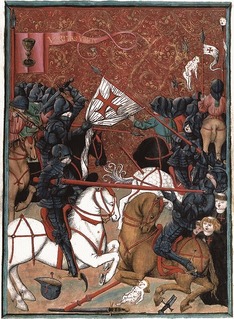
The Hussites were a Czech Proto-Protestant Christian movement that followed the teachings of reformer Jan Hus, who became the best known representative of the Bohemian Reformation.

Jan Hus, sometimes anglicized as John Hus or John Huss, and referred to in historical texts as Iohannes Hus or Johannes Huss, was a Czech theologian and philosopher who became a Church reformer and the inspiration of Hussitism, a key predecessor to Protestantism and a seminal figure in the Bohemian Reformation. After John Wycliffe, the theorist of ecclesiastical reform, Hus is considered the second Church reformer, as he lived before Luther, Calvin and Zwingli. His teachings had a strong influence on the states of Western Europe, most immediately in the approval of a reformed Bohemian religious denomination and, over a century later, on Martin Luther. Hus was a master, dean, and rector at the Charles University in Prague.

Charles University, known also as Charles University in Prague or historically as the University of Prague, is the oldest and largest university in the Czech Republic. It is one of the oldest universities in Europe in continuous operation. Today, the university consists of 17 faculties located in Prague, Hradec Králové and Pilsen. The Charles University belongs to top three universities in Central and Eastern Europe. It is ranked around 200-300 in the world.

The history of the Czech lands – an area roughly corresponding to the present-day Czech Republic – starts approximately 800,000 years BCE. A simple chopper from that age was discovered at the archeological site of Red Hill in Brno. Many different primitive cultures left their traces throughout the Stone Age, which lasted approximately until 2000 BCE. The most widely known culture present in the Czech lands during the pre-historical era is the Únětice Culture, leaving traces for about five centuries from the end of the Stone Age to the start of the Bronze Age. Celts – who came during the 5th century BCE – are the first people we know by name. One of the Celtic tribes were Boii (plural), who gave the Czech lands their first name Boiohaemum – Latin for the Land of Boii. Before the beginning of the Common Era the Celts were mostly pushed out by Germanic tribes. The most notable of those tribes were the Marcomanni and traces of their wars with the Roman Empire were left in south Moravia.
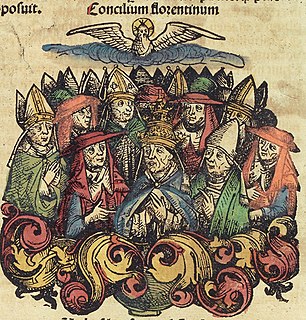
The Council of Florence is the seventeenth ecumenical council recognized by the Catholic Church, held between 1431 and 1449. It was convoked as the Council of Basel by Pope Martin V shortly before his death in February 1431 and took place in the context of the Hussite wars in Bohemia and the rise of the Ottoman Empire. At stake was the greater conflict between the Conciliar movement and the principle of papal supremacy.
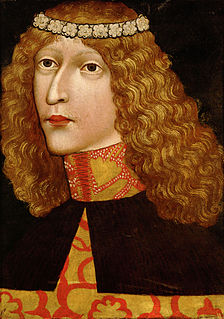
Ladislaus the Posthumous, known also as Ladislas, was Duke of Austria, and King of Hungary, Croatia and Bohemia. He was the posthumous son of Albert of Habsburg with Elizabeth of Luxembourg. Albert had bequeathed all his realms to his future son on his deathbed, but only the estates of Austria accepted his last will. Fearing an Ottoman invasion, the majority of the Hungarian lords and prelates offered the crown to Vladislaus III of Poland. The Hussite noblemen and towns of Bohemia did not acknowledge the hereditary right of Albert's descendants to the throne, but also did not elect a new king.

Jan Žižka z Trocnova a Kalicha was a Czech general – a contemporary and follower of Jan Hus and a Radical Hussite who led the Taborites. Žižka was a successful military leader and is now a Czech national hero. He was nicknamed "One-eyed Žižka", having lost one and then both eyes in battle.

Matthias Corvinus, also called Matthias I, was King of Hungary and Croatia from 1458 to 1490. After conducting several military campaigns, he was elected King of Bohemia in 1469 and adopted the title Duke of Austria in 1487. He was the son of John Hunyadi, Regent of Hungary, who died in 1456. In 1457, Matthias was imprisoned along with his older brother, Ladislaus Hunyadi, on the orders of King Ladislaus the Posthumous. Ladislaus Hunyadi was executed, causing a rebellion that forced King Ladislaus to flee Hungary. After the King died unexpectedly, Matthias's uncle Michael Szilágyi persuaded the Estates to unanimously proclaim Matthias king on 24 January 1458. He began his rule under his uncle's guardianship, but he took effective control of government within two weeks.

The Hussite Wars, also called the Bohemian Wars or the Hussite Revolution, were a series of wars fought between the Christian Hussites and the combined Christian Catholic forces of Holy Roman Emperor Sigismund, the Papacy, European monarchs loyal to the Catholic Church, as well as various Hussite factions. After initial clashes, the Utraquists changed sides in 1432 to fight alongside Roman Catholics and opposed the Taborites and other Hussite spinoffs. These wars lasted from 1419 to approximately 1434.
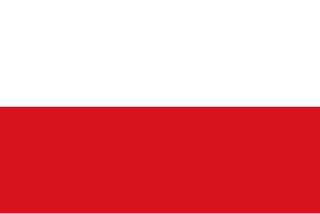
Although the Kingdom of Bohemia, both of the Lusatias, the Margraviate of Moravia, and Silesia were all under Habsburg rule, they followed different paths of development. Moravians include Silesia had accepted the hereditary right of the Austrian Habsburgs to rule and thus escaped the intense struggle between native estates and the Habsburg monarchy that was to characterize Bohemian history. In contrast, the Bohemian Kingdom had entrenched estates that were ready to defend what they considered their rights and liberties. The Habsburgs pursued a policy of centralization and conflict arose, which was further complicated by ethnic and religious issues
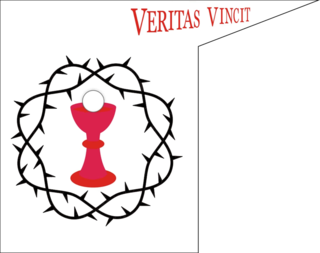
The Taborites, known by their enemies as the Picards, were a radical faction within the Hussite movement in medieval Lands of the Bohemian Crown.
The Transylvanian peasant revolt, also known as the peasant revolt of Bábolna or Bobâlna revolt, was a popular revolt in the eastern territories of the Kingdom of Hungary in 1437. The revolt broke out after George Lépes, bishop of Transylvania, had failed to collect the tithe for years because of a temporary debasement of the coinage, but then demanded the arrears in one sum when coins of higher value were again issued. Most commoners were unable to pay the demanded sum, but the bishop did not renounce his claim and applied interdict and other ecclesiastic penalties to enforce the payment.

The Kingdom of Bohemia, sometimes later in English literature referred to as the Czech Kingdom, was a medieval and early modern monarchy in Central Europe, the predecessor of the modern Czech Republic. It was an Imperial State in the Holy Roman Empire, and the Bohemian king was a prince-elector of the empire. The kings of Bohemia, besides Bohemia itself, also ruled other lands belonging to the Bohemian Crown, which at various times included Moravia, Silesia, Lusatia, and parts of Saxony, Brandenburg, and Bavaria.

Vladislaus II, also known as Vladislav, Władysław or Wladislas, was King of Bohemia from 1471 to 1516, and King of Hungary and Croatia from 1490 to 1516. As the eldest son of Casimir IV Jagiellon, he was expected to inherit Poland and Lithuania. George of Poděbrady, the Hussite ruler of Bohemia, offered to make Vladislaus his heir in 1468. Poděbrady needed Casimir IV's support against the rebellious Catholic noblemen and their ally, Matthias Corvinus, king of Hungary. The Diet of Bohemia elected Vladislaus king after Poděbrady's death, but he could only rule Bohemia proper, because Matthias occupied Moravia, Silesia and Lusatia. Vladislaus tried to reconquer the four provinces with his father's assistance, but Matthias repelled them.

The Kingdom of Hungary came into existence in Central Europe when Stephen I, Grand Prince of the Hungarians, was crowned king in 1000 or 1001. He reinforced central authority and forced his subjects to accept Christianity. Although all written sources emphasize only the role played by German and Italian knights and clerics in the process, a significant part of the Hungarian vocabulary for agriculture, religion and state was taken from Slavic languages. Civil wars and pagan uprisings, along with attempts by the Holy Roman Emperors to expand their authority over Hungary, jeopardized the new monarchy. The monarchy stabilized during the reigns of Ladislaus I (1077–1095) and Coloman (1095–1116). These rulers occupied Croatia and Dalmatia with the support of a part of the local population. Both realms retained their autonomous position. The successors of Ladislaus and Coloman—especially Béla II (1131–1141), Béla III (1176–1196), Andrew II (1205–1235), and Béla IV (1235–1270)—continued this policy of expansion towards the Balkan Peninsula and the lands east of the Carpathian Mountains, transforming their kingdom into one of the major powers of medieval Europe.

In the Late Middle Ages, the Kingdom of Hungary, a country in Central Europe, experienced a period of interregnum in the early 14th century. Royal power was restored under Charles I (1308–1342), a scion of the Capetian House of Anjou. Gold and silver mines opened in his reign produced about one third of the world's total production up until the 1490s. The kingdom reached the peak of its power under Louis the Great (1342–1382) who led military campaigns against Lithuania, southern Italy and other faraway territories.

The Bohemian Reformation, preceding the Protestant Reformation of the 16th century, was a Christian movement in the late medieval and early modern Kingdom and Crown of Bohemia striving for a reform of the Roman Catholic Church. Lasting for more than 200 years, it had a significant impact on the historical development of Central Europe and is considered one of the most important religious, social, intellectual and political movements of the early modern period. The Bohemian Reformation produced the first national church separate from Roman authority in the history of Western Christianity, the first apocalyptic religious movement of the early modern period, and the first pacifist Protestant church.
Religious peace of Kutná Hora was concluded in March 1485 by the Czech lands Diet in Kutná Hora between Utraquist Hussites and Roman Catholics. The agreement between representatives of both sides, reached after meeting from 13 March to 20 March, declared the agreement from the Basel Council the basic law of the land. The Utraquist and the Catholic faiths were declared equal in front of the law, and the religious peace (Landfried) was declared for the following 31 years. This agreement finished a long series of religious conflicts in the Czech lands and constituted a definitive end to the Hussite Wars. The Diet in 1512 confirmed the agreement and extended it in perpetuity. Religious peace and tolerance helped for development of the land, but it contributed to the future conflicts of interests between middle-class and nobility.
The Battle of Živohošť took place on 4 November 1419. Hussite pilgrims from Alttabor came to the countrywide congress in Prague, where they fought the Czech Catholic nobility following King Sigismund of Luxembourg and under the command of Peter Konopišťský of Sternberg. After the first attack, a number of the Hussites were killed, wounded, or captured, but the West Bohemian Hussite reinforcements that arrived from the battlefield from Nový Knín led the Czech barons to retreat to Kuttenberg. According to the testimony of contemporary written sources, the battle at Živohoště was the first major battle of the Hussite Wars.
References
- 1 2 3 Stieber 1978, p. 163.
- ↑ Janišová & Janiš 2016, p. 187.
- ↑ Sedlar 1994, p. 187.
- ↑ Šmahel 2011, p. 163.